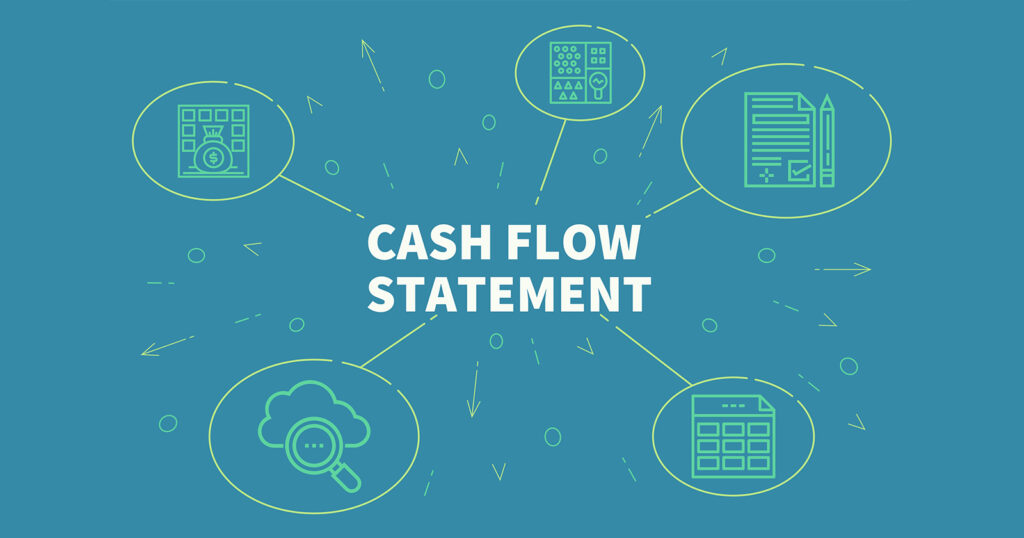The cash flow statement gives a great insight into a company’s cash management. It shows inflows and outflows of money for a specified financial period.
Along with the balance sheet and income statement, the cash flow statement is considered an important section of a set of financial statements. In the accounting world, there are two ways to draft the cash flow statement; the indirect method and the direct method.
We will take a deeper look into the indirect method and illustrate it with an example.

The Indirect Method: Explained
A cash flow statement contains three sections; operating activities, investing activities and financing activities. There are two ways to prepare the cash flow statements. A company can choose the indirect method or the direct method.
The investing and financing activities sections will stay the same whether it’s the indirect or direct method. The section that will differ between the indirect method and the direct method is the operating activities.
In the indirect method, we use the net income coming from the income statement as a starting point. From there, we adjust for any non-cash transactions that are included on the income statement.
For example, if there are amortization costs on the income statement, we have to add those back into the operating activities of the cash flow statement since the amortization isn’t a real cash payment and shouldn’t decrease the net income received.
Another example would be the interest income earned but not received. Since accrual accounting is used in the majority of companies, items like interest income could be earned during one financial period but actually received in the following financial period.
As such, the indirect method dictates that the interest income needs to be removed from the operating activities since the inflow of money hasn’t been received.
We also take into consideration the movement in assets and liabilities accounts from the balance sheet.
- An increase in assets or decrease in liabilities from the current period versus the prior period would mean a decrease in the cash flows from operating activities.
- A decrease in assets or increase in liabilities from the current period versus the period would mean an increase in the cash flows from operating activities.
Read More:
How to Calculate Depreciation Expense: Straight Line Method
A Further Understanding
The logic behind this is simple.
Imagine a company has a higher balance for accounts receivable or has fewer payables in the current period compared to the prior period, this means they are collecting less cash for their sales (so higher accounts receivable) or they are making more payments to their suppliers (so fewer payables).
Those two situations will make the company have fewer cash inflows which is why they each will decrease the cash flows from operating activities.
On the contrary, if a company’s accounts receivable is lower or the payables are higher in the current year versus the prior year, then this means they have collected more cash on sales (so lower accounts receivable) or haven’t paid their suppliers on the same levels as before (higher payables).
These situations mean the company has more cash inflows which increase the cash flows from operating activities.
Difference Between the Indirect Method and the Direct Method
The main difference between the indirect method and the direct method is that the former uses the accrual accounting basis and the latter uses the cash accounting basis.
In the indirect method, as we have explained, we start with the net income of the company taken from the income statement, adjust for any non-cash related transactions and adjust for the movement in assets or liabilities between the current financial period to the prior financial period.
In the direct method, we use the cash basis and the focus is to identify the actual operating cash receipts and cash payments during a financial period.
Generally speaking, the direct method gives a better picture of cash transactions than the indirect method but is more labor intensive than the indirect method which makes the indirect method the popular option adopted in the industry.
Read More:
Closing Entries Accounting Examples (Beginners: Step by Step)
The Indirect Method: Example

Let’s look at an example at Carl’s Construction Company (“CCC”). Since the investing and financing activities do not differ between the indirect and direct method, we will only focus on the operating activities section.
For the financial year ended 31 December, CCC had the following operational transactions:
- Net income of $206,000 as seen in the income statement
- Amortization costs of $10,000 included in the expense section of the income statement
- Provision for bad debt on accounts receivable of $5,000 included in the expense section of the income statement
- Increase of $20,000 on accounts receivable on the balance sheet between the current period and prior period
- Decrease of $30,000 in inventories on the balance sheet between the current period and prior period
- Increase of $4,000 in audit fees payable on the balance sheet between the current period and prior period
- Decrease of $2,000 in legal fees payable on the balance sheet between the current period and prior period
The cash flow statement using the indirect method would look like the following:
| Cash flows from operating activities: | |
| Net income from the income statement | $206,000 |
| Adjustment for non-cash transactions: | |
| Amortization costs | $10,000 |
| Provision for bad debts on accounts receivable | $5,000 |
| Increase in accounts receivable | ($20,000) |
| Decrease in inventories | $30,000 |
| Increase in audit fees payable | $4,000 |
| Decrease in legal fees payable | ($2,000) |
| Net cash flows from operating activities | $233,000 |
Cash Flow Statement: The Indirect Method Recap and Final Thoughts
The cash flow statement can be generated using the indirect method or the direct method.
- The indirect method uses the concept of accrual accounting and takes the net income of a company as a start and strips away any non-cash transactions while adjusting for balance sheet movements in assets and liabilities.
- The direct method uses cash basis accounting and tracks the cash inflows and outflows of the operational activities.
Both methods only affect the operating activities of the cash flow statements while the investing and financing activities are the same between the indirect and direct method.
Since the direct method is more complicated than the indirect method, it is more common for companies to produce the cash flow statements using the indirect method but a cash flow statement that is presented with the direct method paints a better picture of cash transactions of a company.



